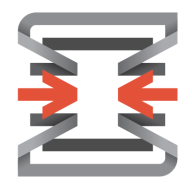


Find out in this report how the two Firewalls solutions compare in terms of features, pricing, service and support, easy of deployment, and ROI.



Fortinet FortiGate offers comprehensive network security and firewall protection across multiple locations. It effectively manages data traffic and secures environments with features like VPN, intrusion prevention, and UTM controls.
Organizations rely on Fortinet FortiGate for its robust integration with advanced security policies, ensuring significant protection for enterprises, cloud environments, and educational sectors. It facilitates network segmentation, application-level security, and authentication management, securing communication within and between locations such as branches and data centers. Its efficient SD-WAN and UTM features enable streamlined data management and enhanced threat protection capabilities. Users appreciate its centralized management, facilitating seamless operations across diverse environments.
What are the key features of Fortinet FortiGate?
What benefits should users expect from Fortinet FortiGate?
Fortinet FortiGate is crucial in sectors like education, offering robust networks for secure data flow between campuses and facilitating remote learning. In enterprise environments, it allows efficient management of application traffic and security across multiple branches, while in the cloud, it seamlessly integrates with diverse platforms to enhance security infrastructure.
Cisco Meraki MX appliances are next-generation firewalls with all the advanced security services needed for today’s IT security. The appliances are ideal for organizations considering a unified threat management (UTM) solution for branch offices, data centers, distributed sites, or campuses. Since Meraki MX is 100% cloud-managed, installation and remote management are simple and zero-touch.
Meraki MX’s hardware and virtual appliances are configurable in Microsoft Azure, Amazon Web Services (AWS), and Google Cloud Platform, and private cloud support is offered through Cisco NFVIS and Alibaba Cloud.
Organizations of all sizes and across all industries rely on Meraki MX to deliver secure connectivity to hub locations or multi-cloud environments, as well as application quality of experience (QoE) through advanced analytics with machine learning.
Cisco Meraki’s advanced QoE analytics offers:
Cisco Meraki’s SD-WAN offers:
The Meraki MX’s SD-WAN is unique in that it can be easily extended to deliver optimized access to resources in public and private cloud environments with virtual MX appliances. Its SD-WAN lowers operational costs and improves the performance of remotely-accessed resources. Users can ensure the availability of the apps and services their employees use most through dynamic path selection, policy-based routing, support for application-layer profiles, and VPN.
Meraki MX offers industry-leading cloud management that has template-based settings which can scale easily from small deployments to tens of thousands of devices. It features an intuitive web-based dashboard for managing mobile devices, united firewalls, switching, and wireless LAN. Users can also benefit from role-based administration, configurable email alerts for a variety of important events, and easily auditable change logs. Meraki MX is capable of producing summary reports with device, user, and application details archived in the cloud.
Meraki MX Key Features
MX has a robust suite of network services in an all-in-one device, which saves you money by eliminating the need for multiple appliances. These services include:
Reviews from Real Users
Meraki MX stands out among its competitors for a number of reasons. Two major ones are its easy management and its ability to be accessed remotely. Below is some feedback from PeerSpot users who are currently using Meraki MX as their firewall security solution.
Craig B., a central services engineer at Liberty Technology, writes, “The web console for managing everything keeps everything on Meraki and keeps us from going somewhere else. It is why I think a lot of people like Meraki. Comparing it to SonicWall or even a different Cisco firewall, like traditional ASAs, managing Meraki is a thousand times easier because of fluidity. You don't have to rebuild a table just to change one rule. It's much more readable for a human.”
Edgardo C., an IT director, notes,”By using the VPN, we can connect remotely. We have two offices, and we could connect them through the VPN. We could establish a network between two sites, and that has improved and increased communication and productivity. Our remote site is able to access the server remotely.”
OPNsense is widely used for firewall functionalities, intrusion detection, VPN and IPSec, content filtering, securing network traffic, and remote access. It protects internal networks and manages servers securely, suitable for small to medium-sized businesses.
OPNsense is a comprehensive firewall solution leveraging open-source technology. It integrates with third-party modules like WireGuard and CrowdSec, enhancing its security capabilities. Offering on-premises and cloud deployment, it features an intuitive graphical interface, advanced reporting, VPN functionality, IDS/IPS features, and high scalability. Users find it ideal for small businesses and home networks due to its stability and ease of use. Frequent updates and an active community support its continuous improvement. However, it needs advancements in VPN selection, scalability, and technical documentation. Enhanced high availability, threat intelligence, and integration with virtualization platforms are required. User feedback suggests improvements in connectivity, alerting, traffic monitoring, and antivirus protection.
What are the key features of OPNsense?OPNsense is implemented across various industries to secure network infrastructure and ensure reliable connectivity. In fintech, it safeguards sensitive financial data while maintaining compliance. Educational institutions deploy it to protect student information and enable secure remote learning environments. Healthcare organizations use it to secure patient data and comply with HIPAA regulations. By integrating with tools like WireGuard and CrowdSec, businesses enhance their cybersecurity posture and streamline network management, making OPNsense a versatile choice for diverse operational needs.
We monitor all Firewalls reviews to prevent fraudulent reviews and keep review quality high. We do not post reviews by company employees or direct competitors. We validate each review for authenticity via cross-reference with LinkedIn, and personal follow-up with the reviewer when necessary.